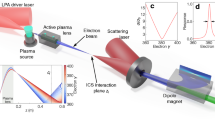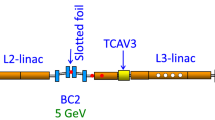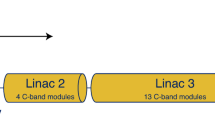Abstract
The maximum achievable photon energy of compact, conventional, Compton-scattering X-ray sources is currently limited by the maximum permissible field gradient of conventional electron accelerators1,2. An alternative compact Compton X-ray source architecture with no such limitation is based instead on a high-field-gradient laser–wakefield accelerator3,4,5,6. In this case, a single high-power (100 TW) laser system generates intense laser pulses, which are used for both electron acceleration and scattering. Although such all-laser-based sources have been demonstrated to be bright and energetic in proof-of-principle experiments7,8,9,10, to date they have lacked several important distinguishing characteristics of conventional Compton sources. We now report the experimental demonstration of all-laser-driven Compton X-rays that are both quasi-monoenergetic (∼50% full-width at half-maximum) and tunable (∼70 keV to >1 MeV). These performance improvements are highly beneficial for several important X-ray radiological applications2,11,12,13,14,15.
This is a preview of subscription content, access via your institution
Access options
Subscribe to this journal
Receive 12 print issues and online access
$209.00 per year
only $17.42 per issue
Buy this article
- Purchase on Springer Link
- Instant access to full article PDF
Prices may be subject to local taxes which are calculated during checkout



Similar content being viewed by others
References
Albert, F. et al. Characterization and applications of a tunable, laser-based, MeV-class Compton-scattering gamma-ray source. Phys. Rev. 13, 070704 (2010).
Achterhold, K. et al. Monochromatic computed tomography with a compact laser-driven X-ray source. Sci. Rep. 3, 1313 (2013).
Catravas, P., Esarey, E. & Leemans, W. P. Femtosecond X-rays from Thomson scattering using laser wakefield accelerators. Meas. Sci. Technol. 12, 1828–1834 (2001).
Umstadter, D., He, F. & Lau, Y. Ultra-short wavelength X-ray system US patent 7,321,604 (2008).
Esarey, E., Schroeder, C. B. & Leemans, W. P. Physics of laser-driven plasma-based electron accelerators. Rev. Mod. Phys. 81, 1229–1285 (2009).
Ghebregziabher, I., Shadwick, B. A. & Umstadter, D. Spectral bandwidth reduction of Thomson scattered light by pulse chirping. Phys. Rev. 16, 030705 (2013).
Schwoerer, H., Liesfeld, B., Schlenvoigt, H. P., Amthor, K. U. & Sauerbrey, R. Thomson-backscattered X rays from laser-accelerated electrons. Phys. Rev. Lett. 96, 014802 (2006).
Ta Phuoc, K. et al. All-optical Compton gamma-ray source. Nature Photon. 6, 308–311 (2012).
Mori, Y. et al. Head-on inverse Compton scattering X-rays with energy beyond 10 keV from laser-accelerated quasi-monoenergetic electron bunches. Appl. Phys. Express 5, 056401 (2012).
Chen, S. et al. MeV-energy X rays from inverse Compton scattering with laser-wakefield accelerated electrons. Phys. Rev. Lett. 110, 155003 (2013).
Boone, J. M. & Seibert, J. A. A figure of merit comparison between bremsstrahlung and monoenergetic X-ray sources for angiography. J. X-ray Sci. Technol. 4, 334–345 (1994).
Carroll, F. E. Tunable monochromatic X rays: a new paradigm in medicine. Am. J. Roentgenol. 179, 583–590 (2002).
Brenner, D. J. et al. Cancer risks attributable to low doses of ionizing radiation: assessing what we really know. Proc. Natl Acad. Sci. USA 100, 13761–13766 (2003).
Giulietti, A. et al. Intense γ-ray source in the giant-dipole-resonance range driven by 10-TW laser pulses. Phys. Rev. Lett. 101, 105002 (2008).
Habs, D. et al. Vision of nuclear physics with photo-nuclear reactions by laser-driven gamma beams. Eur. Phys. J. D 55, 279–285 (2009).
Corde, S. et al. Femtosecond X rays from laser-plasma accelerators. Rev. Mod. Phys. 85, 1–48 (2013).
Tajima, T. & Dawson, J. M. Laser electron accelerator. Phys. Rev. Lett. 43, 267–270 (1979).
Esarey, E., Ride, S. K. & Sprangle, P. Nonlinear Thomson scattering of intense laser pulses from beams and plasmas. Phys. Rev. E 48, 3003–3021 (1993).
Hartemann, F. V. et al. Compton scattering X-ray sources driven by laser wakefield acceleration. Phys. Rev. 10, 011301 (2007).
Geddes, C. G. R. et al. High-quality electron beams from a laser wakefield accelerator using plasma-channel guiding. Nature 431, 538–541 (2004).
Mangles, S. P. D. et al. Monoenergetic beams of relativistic electrons from intense laser–plasma interactions. Nature 431, 535–538 (2004).
Faure, J. et al. A laser–plasma accelerator producing monoenergetic electron beams. Nature 431, 541–544 (2004).
Brunetti, E. et al. Low emittance, high brilliance relativistic electron beams from a laser–plasma accelerator. Phys. Rev. Lett. 105, 215007 (2010).
Gonsalves, A. J. et al. Tunable laser plasma accelerator based on longitudinal density tailoring. Nature Phys. 7, 862–866 (2011).
Banerjee, S. et al. Generation of tunable, 100–800 MeV quasi-monoenergetic electron beams from a laser-wakefield accelerator in the blowout regime. Phys. Plasmas 19, 056703 (2012).
Liu, C. et al. Repetitive petawatt-class laser with near-diffraction-limited focal spot and transform-limited pulse duration. Proc. SPIE 8599, 859919 (2013).
Ross, P. A. A new method of spectroscopy for faint X-radiations. J. Opt. Soc. Am. 16, 433–436 (1928).
Leemans, W. P. GeV electron beams from a centimetre-scale accelerator. Nature Phys. 2, 696–699 (2006).
Liu, J. S. et al. All-optical cascaded laser wakefield accelerator using ionization-induced injection. Phys. Rev. Lett. 107, 035001 (2011).
Pollock, B. B. et al. Demonstration of a narrow energy spread, similar to 0.5 GeV electron beam from a two-stage laser wakefield accelerator. Phys. Rev. Lett. 107, 045001 (2011).
Acknowledgements
The authors thank K. Brown, J. Mills and C. Petersen for their contributions to the laser facility. The authors thank D. Haden and N. Cunningham from Nebraska Wesleyan University for their contributions to X-ray detector analysis. The authors thank C. Wilson, T. Anderson and D. Alexander from the University of Nebraska–Lincoln Electrical Engineering department for precision-cutting of Ross filters. This material is based on work supported by the US Department of Energy (DE-FG02-05ER15663), the Defense Threat Reduction Agency (HDTRA1-11-C-0001), the Air Force Office for Scientific Research (FA 9550-08-1-0232 and FA9550-11-1-0157), the Department of Homeland Security (2007-DN-077-ER0007-02), the Defense Advanced Research Projects Agency (FA9550-09-1-0009) and USSTRATCOM (FA4600-12-D-9000). The views expressed here do not represent those of the sponsors.
Author information
Authors and Affiliations
Contributions
The experiments were conceived and designed by D.U., N.P., S.B., S.C., I.G., C.L. and G.G. Experiments were carried out by G.G., N.P., S.B., S.C., I.G., C.L. and J.Z. Data analysis was performed by G.G., I.G. and N.P. Materials and analysis tools were provided by G.G., I.G., S.B. and N.P. The manuscript was written by D.U. and N.P.
Corresponding author
Ethics declarations
Competing interests
The authors declare no competing financial interests.
Supplementary information
Supplementary information
Supplementary information (PDF 792 kb)
Rights and permissions
About this article
Cite this article
Powers, N., Ghebregziabher, I., Golovin, G. et al. Quasi-monoenergetic and tunable X-rays from a laser-driven Compton light source. Nature Photon 8, 28–31 (2014). https://doi.org/10.1038/nphoton.2013.314
Received:
Accepted:
Published:
Issue Date:
DOI: https://doi.org/10.1038/nphoton.2013.314
This article is cited by
-
Brilliant femtosecond-laser-driven hard X-ray flashes from carbon nanotube plasma
Nature Photonics (2023)
-
Transverse X-ray radiation from petawatt-laser-driven electron acceleration in a gas cell
Journal of the Korean Physical Society (2023)
-
Compact all-optical precision-tunable narrowband hard Compton X-ray source
Scientific Reports (2022)
-
Controlling the characteristics of injected and accelerated electron bunch in corrugated plasma channel by temporally asymmetric laser pulses
Scientific Reports (2022)
-
Quasi-phase-matched laser wakefield acceleration of electrons in an axially density-modulated plasma channel
Scientific Reports (2021)



